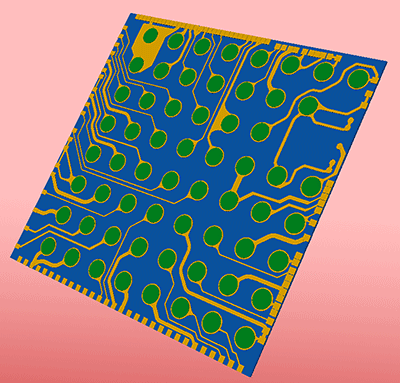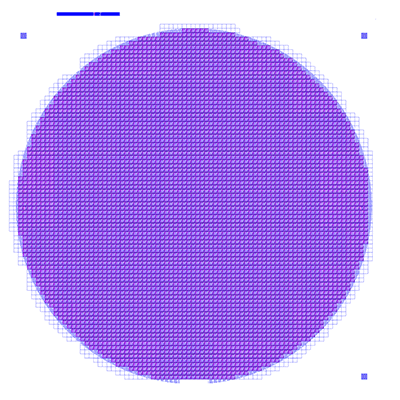Rasterizer Benchmark
We are going to test Artwork's GDS_RIP rasterizer using a typical 300 mm RDL mask as the input. We can then compare the effects of different settings and different hardware on how fast the program can RIP the input data.
The Input File
The input file ( rdl_array_wo_plating_ring.gds.zip 2.34 MB zipped ) was created by taking the RDL circuit and stepping it across a 300 mm wafer. The stepped data was then clipped into a circular shape in preparation for adding a plating ring (which we did not add). Two of the die in the array were replaced with alignment targets.
This input exhibits a lot of repetition and we will compare GDS_RIP -- which does not take advantage of repetition -- to RTCR, a specialized rasterizer that does use the repetition to speed up the raster generation.
The Output Data
We will output compressed TIFF (packbits) in order to minimize the disk IO. This requires some extra CPU cycles to perform the compression but is much faster than writing the uncompressed bitmap to disk.
Banding or Striping
Our rasterizers are able to produce very large bitmaps with limited memory in the computer by dividing the image area into stripes or bands. The "size" of the stripe or band is determined by both the amount of memory available to hold it and the width (or height) of the area to be processed.
Some image writers need the entire bitmap as a single file. Other image writers need stripes or bands of data that align with the approach used to "write" the pixels onto the mask.
32 or 64 bit
GDS_RIP is available as either a 32 bit or 64 bit library. 64 bit is recommended when the image size x DPI gets large. For example, a 350 x 350 mm image area at 8000 DPI will generate about 12E109 pixels or about 1.5 Gbytes of RAM. On a 64 bit machine equipped with 8 GB of RAM this could be done in a single pass; on a 32 bit machine this would require 3-4 bands to fit into the available RAM.
Hardware
The hardware that GDS_RIP runs on will greatly effect the speed. This includes:
- CPU clock speed
- Number of CPU cores
- Amount of RAM
- Disk I/O speed
GDS_RIP's rasterizer is multi-threaded so it can take advantage of 4 and 6 core CPUs. If uncompressed bitmaps are being written to disk then disk IO can become a dominant bottleneck. In such cases we might recommend an SSD to greatly reduce the disk IO.
|


